Remember back in January, when Lulu and I watched all those old commercials, and I told you about her food project? She wanted to learn about food in the U.S. in the last century. Well, she worked at the project for two months, and finally finished it last week for our homeschool group’s history fair. (I wrote about the fair here last year.)
She decided to research each decade since 1910 to learn how food had changed in that decade. The book The Century In Food by Beverly Bundy was a big help, as was the internet.
For each decade she wrote an overview; then she came up with a menu, a few typical school lunches, a recipe and an interesting tidbit from the decade.
A big part of the fun was deciding how to display her information. There are always lots of tri-fold display boards at these fairs, and Lulu wanted to come up with something more engaging. She decided to put each decade’s information on some sort of food container that seemed emblematic of the decade.
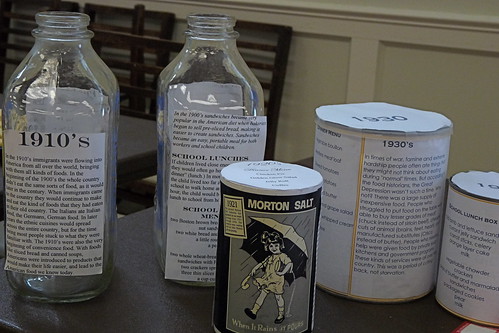
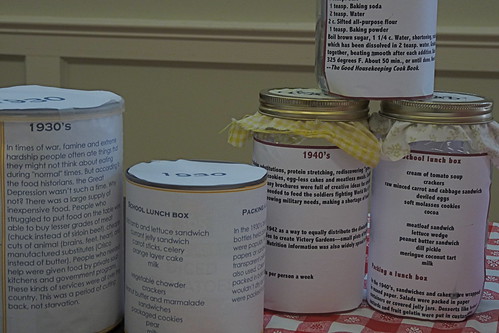 She put the 1960s on an old Julia Child cookbook.
She put the 1960s on an old Julia Child cookbook.
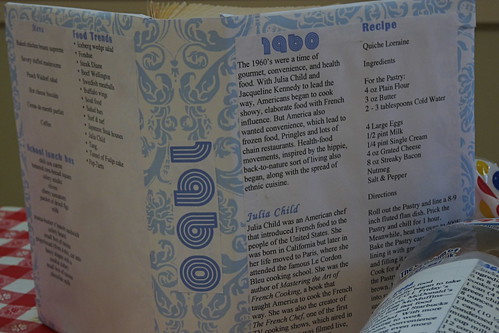
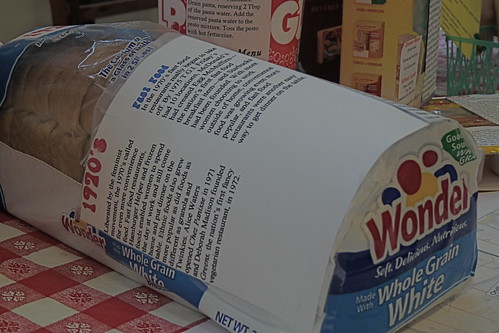
And don’t you love the 80s presented on a Big Gulp container, and the 90s on a package of Lunchables? (Or maybe I should say: doesn’t it make you cringe?)
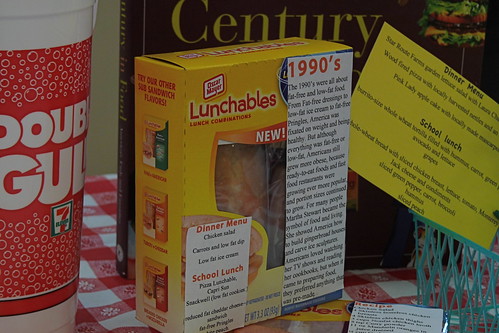
She also made samples for visitors to try: a butterless, eggless, milkless cake from the wartime 1940s (surprisingly good!) and a pineapple upside-down cake from the 1950s. And she ran a loop of those wacky old commercials.
It surprised me how hard Lulu worked at this project. She had a vision for it and wouldn’t stop until it was finished. I think the history fair might have been a little disappointing for her–after all the work she did, it seemed that most visitors weren’t able to spend time to really explore her display. Then again, the main reward seemed to be the accomplishment she felt. If you go back to my last post and reconsider those Dan Pink abilities for the future, I’d say Lulu spent a few months romping in design (how she displayed the information), story (deciding how to tell each decade’s story in a compelling way), symphony (pulling together information from many places and creating something unique) and meaning (this topic mattered to Lulu, which was evident in the amount of time she put into it. Something about it really drove her.)
My favorite part of her display was her write-up of the decade of 2000-2010. Most of the resources she’d used didn’t include this decade, but that didn’t really matter–this was the one decade Lulu remembered herself. We talked about the decade a bit before she wrote, but most of her information came from discussions we’ve had over the last ten years. Lulu gets what’s happening with food in our country these days, and I’m proud of that. I’m not sure that goal would show up on a list of education standards, but it’s pretty important to us.
Here’s what she wrote.
“In the 2000s, the organic and Slow Food movements started to become popular. These movements brought America back towards where it had started at the beginning of the 1900s, buying fresh vegetables at local markets, cooking meals from scratch and using seasonal ingredients. Over the last century Americans had strayed farther and farther from this sort of cooking, until home-cooking meant heating something up or adding water. With the Slow Food movement, Americans began to cook natural, real health food, not the low-fat, calorie-free food that had been thought of as “healthy” in the past. Farmer’s markets, farm boxes of fruits and veggies and health food stores like Whole Foods are spreading across the country, bringing with them the idea that not only is Slow Food healthy, but it’s also delicious and enjoyable to make. Foods like organic eggs and milk, free-range chickens, grass-fed beef and local vegetables are beginning to appear on ordinary supermarket shelves and become staples in American diets. Restaurants are also following the movement, creating organic and seasonal menus that appeal to the next generation as well as the last one. Even First Lady Michelle Obama has chosen as her cause, while in the White House, to improve the eating habits of American children and bring healthy foods back to schools.
Even with these movements, America is still very much a country built on convenience foods, but that is beginning to change. And maybe one day in the near future, America will have come full circle, back to the wholesome, homemade foods of the 1910s.”
Hopeful, don’t you think?
I think she learned a lot.
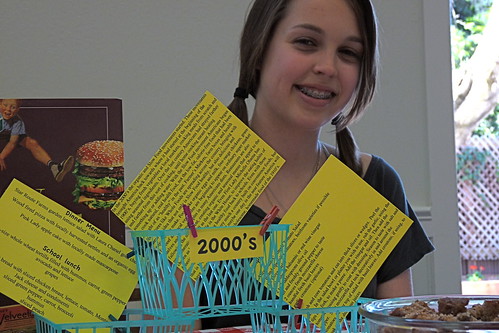

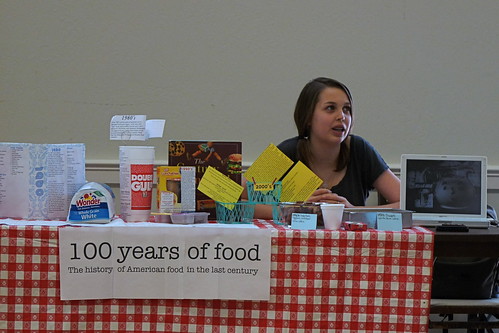
Darn! I wish I could have been there — I want to have a look at those school lunch menus. I’ve always been interested in the way food has evolved — its so fun to stumble across old cookbooks (especially the old parish cookbooks) and see what everyone was cooking.
She really did a fabulous job! Kudos
Thanks, Peaches. Lulu would have loved to have you there too. You can read some of the school lunches in the photos if you look real close. How about a raw minced carrot and cabbage sandwich, ca. 1940? I don’t know about that one…
Mmmm, carrot and cabbage ;( But I think I can top that. I have two friends now in their forties that grew up in England. They used to eat “Butties” – a sandwich made with two slices of buttered white bread sandwiched with potato chips. But then i vaguely remember eating a ketchup sandwich once. Ask Lulu what she thinks of that!
I was so impressed by Lulu’s project. I wanted to spend much more time, but I had Greta dragging me on to the next thing. I think you and Lulu should look for a place to display this project. There has got to be a library or maybe the Hall of Health in Berkeley that would make room in a display case for this amazing project.
Well, L. told me which parents seemed interested in her project–because it mattered to her–and she named you, dragging notwithstanding.
She and I talked about finding a place to display her project too, because it kind of kills her to just pack it away after all her work. The tricky part is that you can’t really see all the writing unless you can physically pick up the items. But maybe she could rework that. She’s also thinking of just putting the writing together into a single document and trying to do something with it. Maybe the county fair…
You’re a dear for suggesting places for her. LHS is a good thought.
amazing! i think her display looked very engaging and creative. you and your children are so inspiring.
Thanks gonzomama. Kids are amazingly inspiring, aren’t they?
Stupendous!
Thanks, Carrie!
I just thought of a place…the cafe at the Lawrence Hall of Science. It has at least one, maybe more display cases. Lulu’s writing on the last decade is magazine article worthy.
I agree with Susan — it would be a make for a great display. I know there are some display cases in the life sciences building, too. I would love to see the project in person!
She put the display in a bag for now. She took the Lunchables “foods” out of the package–but she still had the Wonderbread in a bag in the closet. I asked why she didn’t get rid of it.
“Wouldn’t it just kind of dry up and get hard?”
“Well, usually bread gets moldy,” I said. “But I don’t know about Wonderbread…”
Probably lasts forever. Like a Twinkie.
Hi Tricia,
I bet the lunchables would last quite awhile too. It’s worth and experiment don’t ya think?
I was lucky to visit her exhibit too and shocked by the big gulp. I told her how in the 80’s I saw many girls in college walking around slurping those drinks and calling it a meal! But her plastic cup was even bigger than any I’d seen. It is disgusting that people would drink that much soda or diet drink.
I just watched an interesting show last night in which Jamie ?, the cook from England I know you know about, who had come to America to teach children in a school about eating real food. He found out that the youth couldn’t even identify tomatoes or any vegetable for that matter. They didn’t even know that french fries came from a potato. Many of the adults were completely hostile towards him. He prepared real food instead of processed food in the cafeteria–and the kids finally ate it–but they as well as the adults preferred to prepare and to eat processed food. Americans are truly obsessed with fast food and eat it every day–maybe even for every meal. I hate to sound so judgmental, but it’s sickens me.
L’s final analysis is hopeful, not only the content, but because she recognizes the movement towards change. If only more American parents were as conscience about cooking and talked about it with their kids like you do.
Oh, I wanted to see that Jamie Oliver show! We love him around here. I’ll have to record the rest of the episodes. We were away this weekend, and in the cabin where we stayed we happened to be channel-surfing and we caught Jamie on Larry King.
It’s embarrassing that an English chef is coming to America to teach us how to cook for our families. Then again, here in the SF Bay Area, people have been on this bandwagon for years.
Seeing the last 100 years of food through Lulu’s project does make me hopeful though. Changes in food happen slowly, and it seems like we’re moving in the right direction. Thanks for the thoughtful comments, Kristin!
such an incredible project – right up my alley! i, too, consider it a priority for my children – my whole family really – to learn about food, where it comes from, where it’s been, what it does for our bodies. food is one of the fundamentals that connects all beings. keeping the wonderbread and lunchables around for observation is a great science project – reminds me of supersize me and the mcdonald’s food in jars.
jamie oliver’s TED talk is amazing. i’ve watched the shows too, on hulu. a little high drama, but interesting nonetheless. if anything, watching the shows just helps reaffirm that i’m doing right (mostly) by my kids in the food department. now what grandma does for them when she shows up to take them to lunch, that’s a different story. but that’s not so much about food as it is about making memories with family.
I haven’t seen Jamie’s TED talk. Will do! We’ve been watching his cooking shows for years and we all adore him. All that whizzing things up in the blender and whacking them into the oven…
And I guess we can cut those grandmas some slack. But I do wonder how we’ll spoil our grandchildren some day. Fast food just isn’t going to cut it. Maybe I’ll be the grandma that takes them to–as Lulu calls them–upscale restaurants. Can’t you just hear me: “Come along sweetie, it’s time for our annual trek to the French Laundry.”